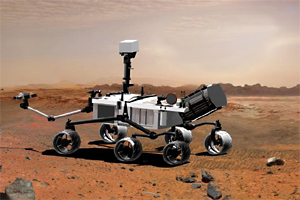 The Mars Science Laboratory. Credit: NASA/JPL-Caltech
The Mars Science Laboratory. Credit: NASA/JPL-Caltech
When I hear about the search for alien life, it's hard not to think about all the science fiction movies with little green men and Earth-destroying spacecraft. But it's an idea that's far from science fiction for scientists at NASA Ames.
NASA is preparing to send their next rover to the surface of Mars, known as the Mars Science Laboratory. It follows the legacy of the twin rovers Spirit and Opportunity, who have survived far longer than NASA scientists expected. After four years, they're still sending data from the Martian surface. (For an update, check out this post from QUEST blogger Ben Burress).
The Mars Science Lab rover will have a few upgrades, though. It's much larger than Spirit and Opportunity and will be nuclear-powered -- meaning no solar cells that are vulnerable to dust storms. It will also be carrying the most advanced lab equipment yet, some of which will look for organic matter on the surface. The goal to discover how habitable the surface could have been for life.
When it comes to what kind of life, it's microbial life that many scientists believe is the best case scenario. There have been a number of recent discoveries that are promising evidence that liquid water once existed on the surface. But if even the conditions were right for life then, they're certainly not right today. Thanks to a thin atmosphere, Mars is bombarded by solar radiation and conditions are dry and cold. Still, many scientists think there's a possibility that life could survive in the subsurface, where it's warmer and more sheltered.
